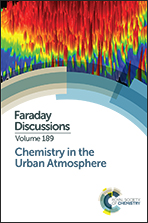Modelling component evaporation and composition change of traffic-induced ultrafine particles during travel from street canyon to urban background
Abstract
We developed a model (CiTTy-Street-UFP) of traffic-related particle behaviour in a street canyon and in the nearby downwind urban background that accounts for aerosol dynamics and the variable vapour pressure of component organics. The model simulates the evolution and fate of traffic generated multicomponent ultrafine particles (UFP) composed of a non-volatile core and 17 Semi-Volatile Organic Compounds (SVOC, modelled as n-alkane proxies). A two-stage modelling approach is adopted: (1) a steady state simulation inside the street canyon is achieved, in which there exists a balance between traffic emissions, condensation/evaporation, deposition, coagulation and exchange with the air above roof-level; and (2) a continuing simulation of the above-roof air parcel advected to the nearby urban park during which evaporation is dominant. We evaluate the component evaporation and associated composition changes of multicomponent organic particles in realistic atmospheric conditions and compare our results with observations from London (UK) in a street canyon and an urban park. With plausible input conditions and parameter settings, the model can reproduce, with reasonable fidelity, size distributions in central London in 2007. The modelled nucleation-mode peak diameter, which is 23 nm in the steady-state street canyon, decreases to 9 nm in a travel time of just 120 s. All modelled SVOC in the sub-10 nm particle size range have evaporated leaving behind only non-volatile material, whereas modelled particle composition in the Aitken mode contains SVOC between C26H54 and C32H66. No data on particle composition are available in the study used for validation, or elsewhere. Measurements addressing in detail the size resolved composition of the traffic emitted UFP in the atmosphere are a high priority for future research. Such data would improve the representation of these particles in dispersion models and provide the data essential for model validation. Enhanced knowledge of the chemical composition of nucleation-mode particles from diesel engine exhaust is needed to predict both their atmospheric behaviour and their implications for human health.
- This article is part of the themed collection: Chemistry in the Urban Atmosphere

 Please wait while we load your content...
Please wait while we load your content...